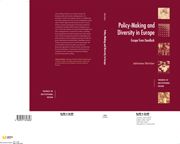Book contents
- Frontmatter
- Contents
- Acknowledgements
- 1 Escaping deadlock: policy-making in Europe
- 2 The context of subterfuge: diversity, fragmentation and the malleability of the European polity
- 3 The analytical approach and theoretical background
- 4 Market-making policy: transport and telecommunications
- 5 The provision of collective goods and the reduction of externalities: environmental policy
- 6 Market-correcting, redistributive policy: regional and social policy
- 7 Market-correcting, distributive policy: research and technology
- 8 Summary and conclusion: stalemate and subterfuge across policy areas
- References
- Index
4 - Market-making policy: transport and telecommunications
Published online by Cambridge University Press: 22 September 2009
- Frontmatter
- Contents
- Acknowledgements
- 1 Escaping deadlock: policy-making in Europe
- 2 The context of subterfuge: diversity, fragmentation and the malleability of the European polity
- 3 The analytical approach and theoretical background
- 4 Market-making policy: transport and telecommunications
- 5 The provision of collective goods and the reduction of externalities: environmental policy
- 6 Market-correcting, redistributive policy: regional and social policy
- 7 Market-correcting, distributive policy: research and technology
- 8 Summary and conclusion: stalemate and subterfuge across policy areas
- References
- Index
Summary
Under which conditions and in what form do deadlock and development emerge in market-making policy? The goal of a European market-creating policy is to eliminate trade barriers so that individual actors may benefit from the exchange of goods, services, capital and labour. However, the large-scale gains obtained from the integration of national markets tend to be unevenly distributed across countries, sectors and groups. Hence, market creation evokes support from liberalisers who expect to benefit and opposition from pro-regulators who expect to lose. Exactly how diverse interests are reconciled by manoeuvring around decisional dead-locks is explored by taking a look at two examples of the European policy of service integration, transport, where I examine the abolition of trade barriers in road haulage, and telecommunications where I focus on the liberalisation of telecommunications services.
Road haulage policy
Articles 3(f) and 74 of the Treaty of Rome state, in general terms, that the Community should develop a common transport policy. For almost three decades, however, transport policy in Europe was considered to be a story of: ‘[f]alse starts, of politically inept Commission proposals, or persistent Council inaction, of divided government views’ (Lindberg and Scheingold 1970: 143). Nevertheless, a basic decision to harmonise was taken as far back as 1965 in order to resolve the competitive distortion between road, rail and inland waterway transport. As regards prices, in 1968 the Council agreed to a system of compulsory bracket tariffs for international road transport.
- Type
- Chapter
- Information
- Policy-Making and Diversity in EuropeEscape from Deadlock, pp. 31 - 50Publisher: Cambridge University PressPrint publication year: 1999



